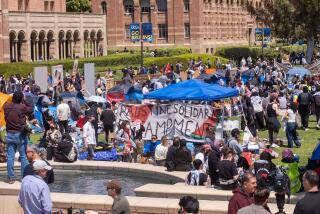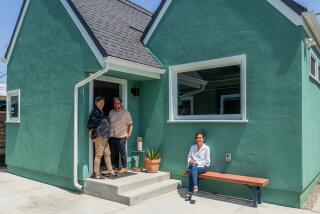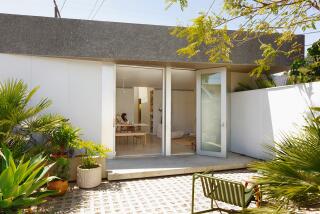USD Campus Is an Unsung Hero
On a clear day, the white buildings of the University of San Diego stand against the sky like some kind of dream vision.
Among San Diego’s college campuses, USD is an unsung hero. It has a sense of romance that’s missing at San Diego State, where tasteful Mediterranean-flavored buildings were joined by lackluster siblings in the ‘60s and ‘70s. Contrasted with the sprawling confusion of the University of California, San Diego, USD’s simple layout along a central spine seems extremely comforting.
Of course it’s not completely fair to compare these three: the small (5,900 students) private college and the two large universities. But, as UCSD and SDSU gear up for massive expansions, they could do well to pay attention to their unassuming neighbor, quietly undergoing its own building boom. Eight significant buildings have been completed in the last 10 years.
Sense of Place
Without any complex master planning, USD has managed to create a powerful sense of place. Regular Interstate 5 travelers can’t help but be inspired by the campus, poised on its mesa just east of the freeway across from Mission Bay. This initial distant impression is quite different from those made by UCSD and SDSU.
UCSD? You think of the central library (never mind that it was already too small to house the school’s books by the time it was completed) and eucalyptus trees, but from the edges of campus, there’s nothing much that symbolizes an important place of higher learning.
SDSU? The view from Interstate 8 is less inspiring, the abysmal service and original art department buildings begging for a merciful earthquake to tumble them off their ridge.
USD, though, is solidly anchored by the Immaculata church. Its blue-domed tower draws you in from a distance, and the building also serves as a visual anchor once you’re on campus. There’s something comforting about being able to look up from almost anywhere and see it. Urban planners have long known that groupings of buildings--whether on a college campus, or in neighborhoods--need such a focus.
The architecturally uninitiated will at first think that USD grew from San Diego’s Spanish roots. After all, there are plenty of arches. But that’s not the case.
“This has nothing to do with California’s history,” said Therese Whitcomb, a campus treasure in her own right, the sensitive overseer of buildings. As director of design (also professor of art and director of the Founders Gallery), Whitcomb helps ensure that new buildings fit precisely the heritage of the campus’s architecture.
“This is Spanish Renaissance,” she said.
And not the kind you find in Balboa Park. That’s Baroque. This is plateresque, an earlier style (1492 to 1556) named after plateros, silversmiths who put fine detail into their work. Plateresque architecture is characterized by the fine detail of its ornamentation, applied in flat, two dimensional fashion, not the more undulating, three dimensional forms which appeared during the later Baroque period.
Several Influences
Spanish Renaissance architecture shows several influences: the medieval vernacular buildings of Spain, with decorative moldings and trim based on plant forms; proportions from ancient times that show up in details such as pilasters, columns and arches; and Moorish elements, such as pointed arches.
The first planning for the campus was done in the late 1940s by Mother Rosalie Hill. She developed a master plan and worked with architect Frank L. Hope Jr. to refine architectural details. Marian Way, the main street through campus, creates a strong central axis, an organizational tool used in Renaissance and ancient times.
This simple plan gives the campus a logic lacking at SDSU or UCSD. Students know they need only cruise the main street to run into their friends. Between classes, Marian Way is packed with young scholars strolling its length, stopping under palm trees to talk, gathering near finely detailed arched entries to buildings like Founders or De Sales halls.
Although the layout at first seems simple, there are subtleties. As Whitcomb pointed out, Marian Way has a slight bend to it. From the eastern end of campus as you walk west, you can’t quite see the other end. Curiosity draws you on. Also, the main road rises and falls slightly, so that your perspective of buildings constantly changes as you walk.
Attention to detail and quality at USD is painstaking, another lesson for other colleges. Landscaped interior courtyards offer many serene places to study. Deep-red quarry tiles cover floors.
At Whitcomb’s insistence, interior walls are slowly being restored to their original flat pigmented plaster finish, instead of the shiny enamel applied in the 1970s. Many ceilings are being repainted the original sky blue. Unfortunately, stricter fire codes in recent years forced the enclosure of open-air corridors.
USD has buildings by several of San Diego’s architectural stalwarts: four by Hope (Founders and Camino); two by Roy Drew (Copley Library and the University Center), and three by Tucker Sadler (Olin Hall, the Douglas F. Manchester Executive Conference Center and the Hahn School of Nursing). Edwin Ulrich also contributed several key buildings, including the Immaculata church, the law school building and De Sales Hall.
Sensible Organization
The message USD sends to campus planners elsewhere is not that they should all consider a return to the Renaissance. It’s that they need to focus on sensible organization and quality detailing. An organic layout like UCSD’s, with its many paths meandering off through the trees, and buildings unrelated to each other when it comes to circulation, offers variety, but also a sense of disorientation.
Whitcomb doesn’t necessarily think the Spanish Renaissance is an appropriate source of inspiration for every college. But she has her reasons for believing a campus benefits from quoting historical architecture.
‘It’s required if students are to get any respect for history and tradition. Without it, we are floundering and insecure. Young people today need roots and a sense of tradition, particularly Southern California students who have never seen anything older than their parents.”
DESIGN NOTES: Architect Rob Quigley is designing 50 units of low-cost family housing for the San Diego Housing Commission, to be built in North City West, the huge instant community east of Del Mar. . . . Internationally known architect Edward Larrabee Barnes, designer of the new 318-acre StoneCrest Business Park in San Diego, lectures at 7 p.m. Thursday at the New School of Architecture, 1249 F St. . . . Architect Chuck Slert is doing two significant office buildings in Phoenix and an unusual glass pyramid office building on Miramar Road in San Diego. . . . Developer A. J. Lirot and architect Dale Naegle recently met with Partners for Livable Places to get comments on the design of Lirot’s proposed residential high-rise downtown. It’s one of three projects being considered for a site at State and Broadway.
More to Read
Sign up for Essential California
The most important California stories and recommendations in your inbox every morning.
You may occasionally receive promotional content from the Los Angeles Times.










